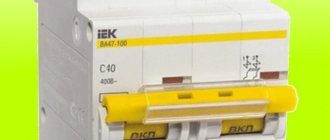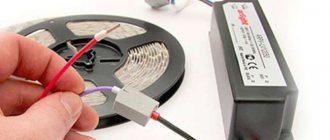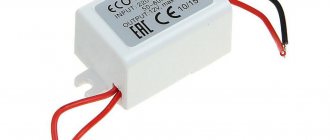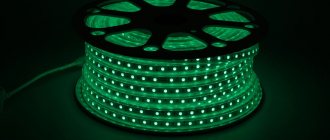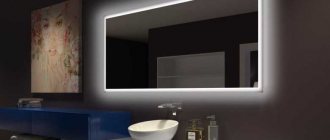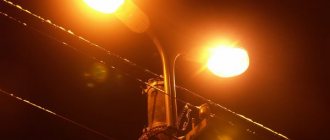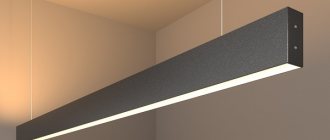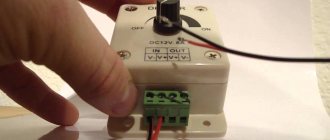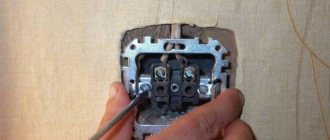Lack of light negatively affects the development of seedlings. Photosynthesis in plants is inhibited, leaves and stems begin to fade. Vegetable growers solve the problem by installing artificial lighting from lamps. Yellow or white glow has a positive effect on the process of photosynthesis, but does not bring any other benefits. The entire necessary spectrum contains sunlight, which promotes the development of cells, leaf plates, and the formation of inflorescences. Illuminating seedlings with LED strips of different luminescence allows you to get as close to this indicator as possible.
Which spectrum is better for backlighting?
We all know that natural light has many different rays: red, blue, orange. When creating artificial light, you need to get as close to natural light as possible. Many modern development technologies in the field of lighting have allowed LED strip to become the most suitable option. And here's why: during plant photosynthesis, not the entire spectrum of light is active, but only waves with a length of 380–710 nm. All rays are responsible for a separate process in the life of plants, and accordingly the intensity of their absorption is different. Of the entire emitted spectrum, three colors are especially useful for seedlings:
- blue – stimulates growth;
- red – accelerates the process of formation of inflorescences;
- pink – combines the useful functions of blue and red.
Note that a specific type of plant requires an individual set of light rays. If you choose them correctly, you are guaranteed to get not only growth, but also excellent flowering and fruit ripening. With the right selection, only LED strip can absolutely replace sunlight.
Advantages of using LED strips
LEDs have the main advantage - they emit the spectrum of light necessary for seedlings, but there are a number of other important advantages:
- the tape consumes little electricity;
- LEDs emit light waves of different lengths, which are better absorbed by plants;
- the tape is designed for a long service life;
- low voltage operation makes the LED strip fire and electrical safe;
- LEDs have minimal flickering and no UV or IR radiation;
- LEDs are environmentally friendly due to the absence of harmful substances, such as mercury.
The downside is the cost. The price of a good LED strip with a power supply is 7–10 times more compared to a cheap LED light bulb, but the backlight will pay for itself in a couple of years.
Selecting a backlight strip
Many vegetable growers are frightened not by the cost of the LED strip, but by the lack of experience in choosing and connecting it. There is nothing complicated about this. When purchasing an LED strip, look at the following characteristics:
- Brightness of the glow. LEDs are identified by a four-digit number. The higher the value, the brighter the light the tape emits.
- Volume of light. A certain number of LEDs are soldered onto 1 m of the base: 30, 60 or more pieces. As the number of bulbs increases, the LED strip emits a larger volume of light.
- LEDs differ in their beam angle. Bulbs come with an indicator of 80 or 120⁰. When using one strip to illuminate a large area, it is better to choose a product with a luminous angle of 120⁰.
- In order not to get confused in the four-digit designation of LEDs and their quantity, you can simply read the luminous flux value marking on the product packaging, indicated by Lumens (Lm).
- The cost of a strip with the same number of LEDs and their quantity varies. As an example, the photo shows a comparison of two products, where LEDs with number 5630 are used in the amount of 60 pcs/1 m, but the power and volume of light differ.
- It is optimal for illuminating seedlings to choose a product with LED number 5630, power 20 W/m and luminous angle 120⁰.
Important! There is an IP designation on the product packaging. This indicates the degree of protection. When determining which LED strip is best for illuminating seedlings, preference is given to a product with a high IP value. LEDs have a silicone coating that protects from moisture and mechanical damage.
LED spectrum length for plants
It has been established that biological processes occurring in plants require a certain length of light waves. Figure 1 provides a graph demonstrating this relationship.
Dependence of plant sensitivity on a specific spectrum
Designations:
- A – graph of the dependence of chlorophyll synthesis;
- B – photosynthesis;
- C – photomorphogenesis.
We see that plants absorb light waves with a length of 445 nM and 660 nM most intensely, falling in the blue and red parts of the spectrum. This is why conventional sources are not suitable for artificial lighting; you will need a phytolamp or phytolape. The most effective backlight, in which the ratio of blue and red light is 1 to 4-6.
Making a lamp with your own hands
Homemade lighting device.
Photo used as illustration. Source: Yandex.Pictures Making them yourself will not be difficult, even without special experience. The main thing is to follow clear instructions:
- Clean the ends of the wires and treat them with a special liquid.
- Attach the matrices to the wires, which must first be connected by plus and minus.
- Place the wires on the LEDs connected to the power supply.
- Fix the LEDs on the plate using glue. For this, epoxy-based glue is used.
- To place the lamps you need to choose the reflective side of the aluminum.
How to attach an LED lamp to a panel?
In the event that the installation will be carried out independently, you need to make sure that during the process of caring for the seedlings, the tape does not interfere with this.
Attention! You cannot connect the tape in question directly to a network that has 220V.
It is best to attach the tape to an aluminum panel. The installation process is as follows:
- Clean the surface of the panel from dirt and dust, degrease it;
- If necessary, cut the tape to a certain length between soldering;
- Remove the protective layer from one edge of the tape. Underneath there is glue, which will be used for installation. If there is no pre-applied layer of glue, epoxy glue or rivets are used for fixation;
- Using little effort, secure the material to the panel, lightly pressing it to the base. Do not allow the tape to bend, as this may damage it;
- Secure the panel in the right place and place the seedlings under it;
- Observing the polarity, connect the tape. Otherwise, the diodes will not light up.
Advantages of phytolents over other sources
Here are several factors that speak in favor of LED backlighting:
- lower consumption compared to halogen, mercury and luminescent phytosources;
- narrow spectral range guarantees maximum efficiency;
- low supply voltage increases the level of safety;
- high efficiency;
- less susceptible to heating than light bulbs, therefore, they can be placed closer to the plants, which allows the use of a source of lower intensity;
- do not contain substances that pose a health hazard.
Phyto-tape with a ratio of blue and red light of 1:5
Unfortunately, such a source has one significant drawback that limits its widespread use - high cost, so we will consider alternative options.
Video review about phytolamps and their manufacturers:
2) China or? Professional American or European phytolamps are not yet available to us (and they cost a lot of money, just not real), and those that are available are Chinese, issued under European brands!!! Therefore, feel free to buy Chinese ones, and do not overpay for deceiving sellers and distributors. The Chinese now have more than fifty factories specializing in the topic of phytolight. And many do it very well. You will know how to choose and what to look for after reading this article to the end. All LEDs are mostly made in China anyway! (and the lamps can be assembled even in the Moscow region). But I don’t recommend domestic ones yet - the fact is that the ones I saw were very weak in characteristics, and were presented as “super duper”. Or I also met the cheapest Chinese ones under the guise of “ours,” but with a good markup. In short, a buyer's scam.
3) HPS or LED? I'll say it briefly. They are very close in their positive effect on plants. HPS is good for growth, but dangerous (strong heating, high currents), my friend’s HPS exploded behind his back (well, behind his back) and I pulled out the smallest fragments from his back for about thirty minutes. Personally, what depresses me most about DNAT and similar systems is the complexity of the installation (there are many requirements on how to do it wisely - it will be difficult for beginners to take everything into account), the presence of additional equipment and losses, and the fire hazard. As a result, according to my data, LEDs will be 30–50% more efficient overall (again, if you take the right phytolamps and install them as needed, and not as you might think). LEDs are safer and simpler no matter what (I’m always afraid of getting a pinch when the equipment works for a long time and unattended).
4) Why LEDs at all? Here you can read theories, but it’s difficult to find; I even had to sit with translators and read reports from foreign scientists (I couldn’t find our specialists in this field). I will summarize the main thing that is worth remembering and accepting: A) plants perceive light in the wavelength range from 400 to 700 nm. B) There are two wavelength regions at which growth is most susceptible: 420-470 and 620-670 n.m. C) Red light in the range 620-670 (even more than 660 nm) is almost 1.5 times more effective than the blue range. But it is worth understanding that this is within the framework of universality. Sometimes some plants have different priorities at different stages. D) The intensity of photosynthesis is higher in the red range, because it is proportional to the number of quanta (not energy). The number of quanta per watt in red light is simply greater! As a result, we have the following data. What about LEDs? Yes, the whole point is that LEDs can be created with very specific emission properties and a narrow range, spending precious energy precisely on the spectrum that gives the greatest effect for the plant! This is the main advantage on which LED phytolamps are based. All other advantages of LEDs have long been known.
5) Cheap LEDs. The characteristics of LEDs vary greatly. I won’t go into detail, I’ll tell you the gist. One powerful LED is better than 100 cheap low-power LEDs with questionable characteristics! Remember this. There are, of course, cases when it is convenient to use not very powerful ones, for example, if you are making a growing setup with low-height trays and shelves, then it is better to use less powerful LEDs, but distributed over a larger area. In good LED phytolamps (lamps), the LEDs should have a rated power of 1 to 5 W. And the rule: expensive, good LEDs have higher efficiency for you and your plant (both in terms of energy savings and impact on the plant).
6) Homemade phytolights made from LEDs. Of course, you can buy the parts yourself, pick up a tool and make a lamp. But there are many pitfalls, because of which 99% of those who try will remain dissatisfied with the result... 1. Good LEDs can be bought rarely and from specialized companies, and not at junk shops or online stores of junk for a ruble! 2. LEDs need a control driver. A lot will depend on his work. So there are problems with these drivers in the market. You definitely won't find any cheap ones. My friend makes lamps for cars and in the end was forced to assemble the drivers himself! 3. Design and cooling. Again, I’ll turn to my friend’s experience: I have to mill the radiators myself and he had a LOT of problems due to the “burning” of the LEDs associated with the incorrect operation of the cooling system. Many LEDs have very poor cooling substrates and sometimes it is impossible to get a good result from them - there will be overheating and both drivers and LEDs will burn. This needs to be done in a complex manner and LEDs must be selected very carefully. This will take a lot of time in artisanal conditions.
As a result, you still won’t be able to compete with China. It makes sense to do this only if you specialize in this area and do everything on a commercial scale.
7) What parameters are important? What to look for when buying? But what is really important: the PAR characteristics and the cooling system of the LED phytolamp! I'll tell you about the cooling system below. What is PAR, in simple and understandable language? This value shows us exactly the energy efficiency of the lamp in the process of plant growth (photosynthesis). How much of the “micro moth” we need will be given by a certain lamp at a certain distance from the plant. This value is measured with a special device - a spectroradiograph (and not a lux meter!)! Most manufacturers of old-style lamps (classic), which are used to installing for plants, do not even provide data on the PAR value. Draw your conclusions! (for example, many professional factories in China that make lamps for plants have them).
 Quality and durability. Quality, of course, is different for everyone. I am currently testing many samples of Chinese industrial products. Some you want to throw away right away, others at least sell as a standard! Wait for reviews and tests. Or write to me, I’ll tell you what I can do. And the durability of LED lamps largely depends on how the cooling system is made. Although the LED does not emit as much heat as other types of lamps, it still emits it very concentratedly (since it itself is very small). As a result, there should be decent radiators and heat dissipation. Bulbs with an E27 base must have a good aluminum radiator (external). And the modules also have built-in fans! How to check whether a lamp is good or not - after several hours of operation, measure its temperature. The lower the temperature on the radiator or lamp body, the better. In normal mode it is within 60C. If it is over 100C, this lamp will not last long (not 50,000 - 100,000 hours exactly, but less).
Quality and durability. Quality, of course, is different for everyone. I am currently testing many samples of Chinese industrial products. Some you want to throw away right away, others at least sell as a standard! Wait for reviews and tests. Or write to me, I’ll tell you what I can do. And the durability of LED lamps largely depends on how the cooling system is made. Although the LED does not emit as much heat as other types of lamps, it still emits it very concentratedly (since it itself is very small). As a result, there should be decent radiators and heat dissipation. Bulbs with an E27 base must have a good aluminum radiator (external). And the modules also have built-in fans! How to check whether a lamp is good or not - after several hours of operation, measure its temperature. The lower the temperature on the radiator or lamp body, the better. In normal mode it is within 60C. If it is over 100C, this lamp will not last long (not 50,000 - 100,000 hours exactly, but less).
9) What are the real advantages of LEDs? Let me briefly summarize what advantages I received for myself: — safety; - efficiency; — efficiency in a convenient package; — durability;
I hope now you know more and will better navigate LED phytolight. In any case, if you have any questions or objections, write or call me, I will be glad!
Recommended reading
- LED phytolamps against HPS
- Research on increasing the efficiency of fluorescent lamps
- 10 advantages of LED phytolamps
- 100 facts about phytolamps and phytolight
Full Spectrum LED Plant Growth Strip
Sometimes RGB sources are called this, which is not correct, since installing full-spectrum LEDs on a strip is technologically impossible.
The USKI source is a blue spectrum LED coated with a special luminescent layer. This design allows luminous flux to be emitted in the range of 400-800 nM, with the peak intensity occurring at 630-640 nM (spectrogram shown in Figure 3).
Figure 3. Spectrogram of USKI LED
Some unscrupulous manufacturers indicate a peak intensity of 660 nM in their products; this, to put it mildly, does not correspond to reality, since the technology used does not allow obtaining a source with such a characteristic. This limitation can be circumvented when making matrices; for this purpose, I install several crystals of the red spectrum in them.
LED and LED matrix manufactured using USKI technology (proportions not respected)
The cost of this type of LED source is not much less than phyto tape, which makes it not an entirely acceptable alternative.
Buy phytolamps with a guarantee
This is a very important point. Manufacturing companies and conscientious sellers must issue a warranty for the lamp. It is very important. If you buy a lamp from an unverified seller, you will not be able to prove to him that it failed not through your fault, but, for example, due to a power surge. And not everyone will undertake to repair such a lamp. Therefore, choose LED bulbs that come with a minimum 1-year warranty.
Some companies, including Minifermer.ru, offer post-warranty service, which is also important. After all, if one diode fails, it will be replaced immediately. And you don't have to figure out which diode is needed and how to solder it.
If you are an avid summer resident who is used to “preparing the cart in winter,” take care of the future harvest now. With lamps from the Minifermer.ru company, your seedlings do not face a lack of light and heat on the windowsill.
Using blue and red LED strips
As an economical option for illuminating indoor plants, red (630nM) and blue (465nM) LED strip can be used. Their peak intensity is somewhat shifted from the phytospectrum, but this is not critical; the effectiveness of such lighting will decrease, but only slightly.
LED strips of red and blue spectrum
Instead of two strips of different colors, you can use one RGB, but to control its operation, in addition to the power supply, you will need a special controller, which makes the design more expensive.
https://www.youtube.com/watch?v=WD_dRwpvje8&feature=youtu.be
Options for placing lighting for seedlings
- Individual illumination of plants with LEDs.
- Racks for plants.
Individual plant lighting.
Spot lighting of plants will not only avoid the annual relocation of all pots and flowerpots to the wintering place, but also create a unique, inimitable interior design. Miniature but powerful LEDs can be used as a lighting source.
LEDs for illuminating plants are capable of producing up to 120 lumens and can be used both as illumination for a plant and as a night light.
For individual lighting, you can buy a specialized LED phytolamp, which we wrote about above. The calculation method is the same as for the LED strip.
Racks for plants.
If there are a large number of lighting objects, it is more advisable to make shelves at the bottom of which the LED strip for plants will be mounted.
Racks can be protected with reflective materials: foil, metallized insulation. This will provide round-the-clock illumination, but will not interfere with rest in the evening. Also, such a screen will increase the illumination of plants by 10-15 percent.
Please rate the article. We tried our best:)
Did you like the article? Tell us about her! You will help us a lot :)
Calculation of backlight power and tape length
To illuminate indoor plants or seedlings, the lamp power is selected at the rate of 30-50 W per square meter (in the presence of natural light). Knowing the characteristics of the LED strip and the area of the indoor greenhouse, it is easy to make the necessary calculations.
Let's say we need to organize lighting for a seedling box with an area of 0.2 m2 (20x100) cm, therefore the power of the lighting source should be 8 W (40 * 0.2). If you choose tape 3528-60 (4.8 W/m), then you will need two meters of it.
Don’t forget about the ratio between red and blue LEDs, which means we take 0.5 m of blue tape and 1.5 m of red, that is, 1 to 3. As a result, there will be 30 blue LEDs and 90 red LEDs in the backlight.
You should pay attention to the peculiarity of the tapes, it consists of segments, each with three LEDs, this is an indivisible part that determines the cutting frequency. For 3528-60 this parameter is 5 cm, and for 3528-120 it is 2.5 cm. In Figure 6, the red circle marks the place where cutting can be done.
Fig.6. The tape can only be cut in the indicated places
To illuminate house plants, it makes no sense to use a silicone-coated tape, especially since it reduces the intensity of the light flux.
Varieties
There are few varieties of LED strips as such. They all work on a similar principle. The LED works thanks to two semiconductors with positive and negative poles.
LED strips differ roughly in just two electrical characteristics.
- Number of flowers. Or, in other words, the emission spectrum. LED lamps are divided into monospectral and multispectral.
- Brightness. Without connecting to a power source, you can determine the luminous intensity of the diode by the markings. There are three types in total - SMD 3528, SMD 5050 and SMD 5630. The numbers indicate the length and width of the diode. And the larger the LED, the higher the brightness.
Separately, the tapes themselves differ in their protection from environmental influences. They come with protection from dirt, dust and moisture in the form of a silicone coating. At home, as a rule, phytotape for plants works well without such protection.
Power supply for backlight
Having decided on the power of the tape, we select a power supply for it. Here it is necessary to take into account the characteristic features of LEDs; they require current stabilization, not voltage. Ohm's law will help you calculate the current consumed by the tape: I=U/P, where U is the supply voltage of the tape, P is its power. For example, for a lamp consuming 9.6 W, you will need a power supply (12 V) of at least 0.8 A (12/9.6 = 0.8). The cost of such devices is about 100-120 rubles.
Inexpensive 12 V and 1 A power supply
Considering the low cost of power supplies of this class, it makes no sense to make them yourself; for the “ham radio itch” it is better to find a more worthy use.
Making a more powerful current stabilizer with your own hands is also pointless; on the well-known website of Chinese manufacturers, you can purchase such a product, as shown in Figure 8, for only 50 rubles (with free delivery).
Figure 8. 3 A current stabilizer (China)
Please note that the device shown in the figure is a current stabilizer, designed for an input voltage from 3.5 to 35 V (DC), accordingly, it cannot be connected directly to a 220 V outlet. It is first necessary to lower the voltage and convert it from AC to DC, that is, assemble a simple circuit based on a transformer, a diode bridge and a polar capacitor (see Fig. 9).
Figure 9. Schematic of a basic power supply
The advantages of such lighting
LED lighting is considered the most suitable because it has a number of positive properties:
- Their wavelength is much longer than that of conventional incandescent lamps. This creates favorable conditions for photosynthesis;
- They produce light of the required brightness, which is their feature;
- Such lamps consume much less energy than conventional lamps, which allows you to save a significant amount of money;
- They are characterized by a low supply voltage, which allows them to be installed close to a water source. In this case, they do not pose any threat to others;
- The plants do not dry out because they are practically not heated;
- Do not have a stroboscopic effect;
- These lamps do not generate ultraviolet or infrared radiation, thus creating safe conditions for the development of some seedlings;
- Made from environmentally friendly materials;
- They are completely fireproof;
- They have a long shelf life (on average this figure is 50 thousand hours), the light bulbs almost never burn out.
This is what the LED strip looks like up close.
Photo used as illustration. Source: Yandex.Images A large list of advantages explains the high popularity of this type of lighting.

